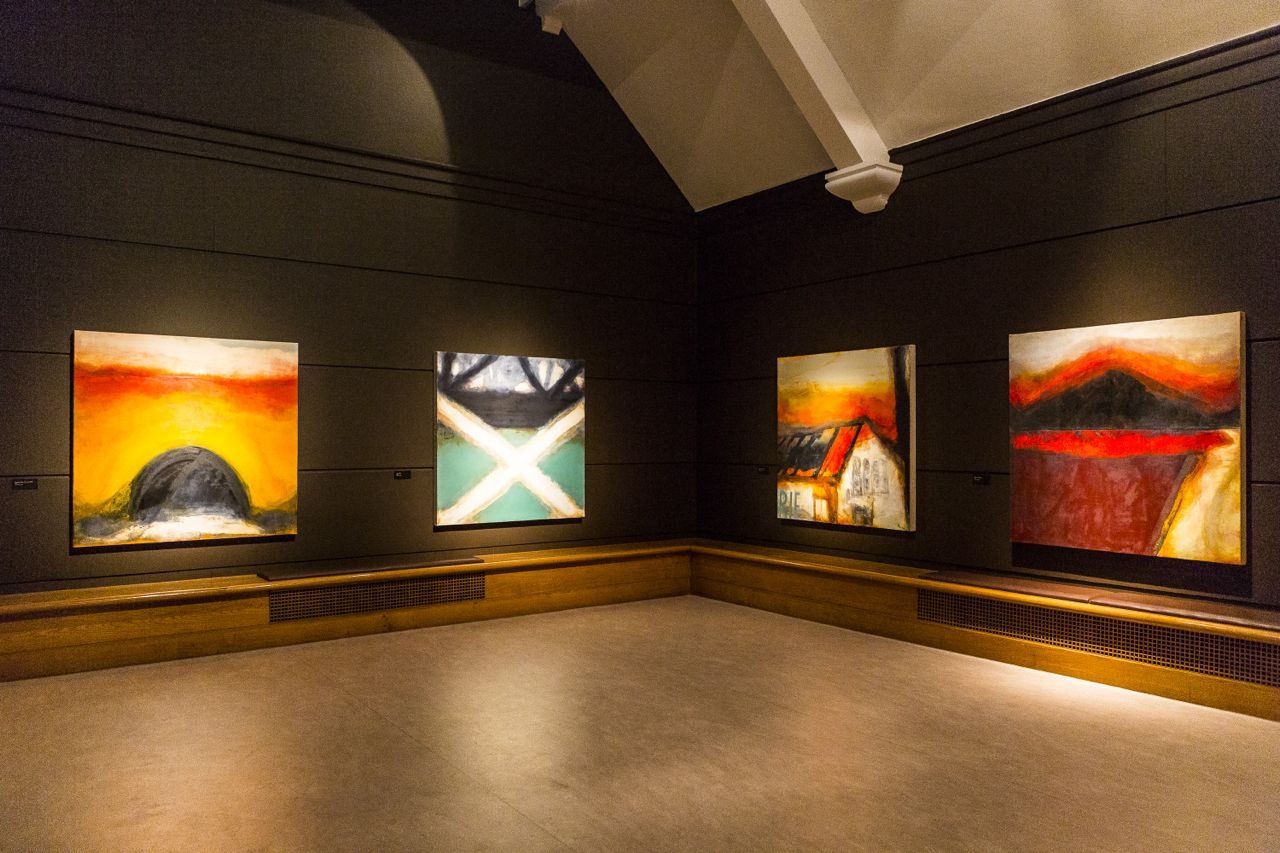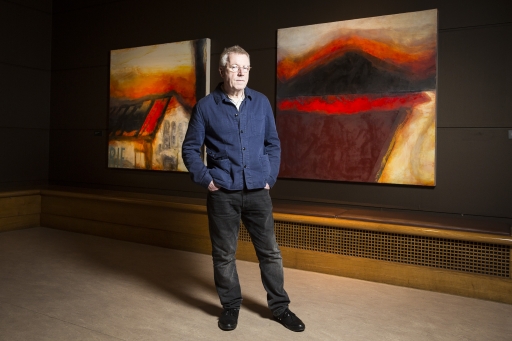A new exhibition to commemorate the beginning of the Battle of the Somme has opened in London at Leighton House Museum in Holland Park. Artist Hughie O’Donoghue talks to Patrick Gregory about his work.
The seven paintings, which are on loan from Eton College, form a collection called Seven Halts on the Somme and were first shown at the school’s Verey Gallery in 2014. It was decided to bring them out of the college now to reach a wider audience, to mark the centenary of the battle.
The large abstract pictures are the work of London-based artist Hughie O’Donoghue and have an unusual pedigree, the result of a collaboration between artist and school over a number of years. The connection began after a chance meeting between O’Donoghue and Eton’s drawing master Ian Burke in 2012.
The two men spoke about the Somme and First World War – Eton lost a disproportionately high number of pupils and past pupils in the war – and Burke invited the artist to come to the school to pour over some of the wealth of material there in the Macnaghten Library, a large collection of maps, photographs, books and ephemera.
One of the bloodiest and costliest of all the battles of the First World War, a defining symbol of the conflict from a British point of view, the Somme had long held O’Donoghue’s interest. He had studied it and travelled to the battlefields and cemeteries and was keen to see if there was something he could do which might act as a memorial to the war dead.
‘I know the Somme well, the history of it, and most British people have an understanding of it’, says O’Donoghue. ‘But more than that, in terms of understanding that history – the sense of how comparatively recent it all is – most people have a sense of what 100 years represents. They may know people who are 90 years old. So it still has a resonance. The events of 1916 were so seismic and there’s still a meaning to it and the wars of the 20th century which are still affecting us.
Legacy
‘I was interested in the response to the Somme as an event. History is always told with the weight of victory or loss and Eton had something in the order of 1000 losses. This and my ongoing work is about how we deal with the legacy of the past – memory which forms a sense of identity of who we are. My curiosity is to excavate layers of the sense of what that truth is. Ian Burke knew that I wanted to unravel the past and come at it from an oblique angle’.
Which is precisely what happened. He took a residency at the school for six months from the summer to Christmas of 2013. It wasn’t enough time to fully develop all his themes or complete all his paintings – that was finished in the privacy of his own studio back in Greenwich in the months after – but gradually a body of work began to inspired by what he found. Work which in itself was abstract but which was meant to capture some of the essence of that long and bloody conflict. ‘I’m known for my abstracted landscapes and in the Seven Halts, and in these war landscapes, the figures are gone. You get the feeling of absence’.
‘It was a very useful experience working at Eton. The students could come in to talk. They were very curious and inquisitive – charming – and an understanding developed with them which was very positive and productive; there was an impetus to the work’.

View of the Leighton House exhibition ((Photo: Kevin Moran Photography)
The seven paintings – paintings like Sausage Valley, Warlencourt Ridge and Pozières – mark a journey for the British troops who fought on the Somme between July and November 1916. The halts are the stopping points and battle zones which defined their experience. Seven different men are commemorated in the collection, some from Eton: four whose bodies were found and who are buried in military cemeteries in France; two who were entirely lost to the war and whose names only appear on the Thiepval Memorial; and one who survived.
That latter person was Arthur Charles Sheepshanks, an officer and Old Etonian who served in the 8th Rifle Brigade. Injured earlier in the war, Sheepshanks somehow clung on through this bloodiest of conflicts, the only officer in his battalion to do so; and indeed he went on to pass beyond the Somme to the end of the war itself. But his schoolmate and fellow officer Edward Foss Prior, another commemorated in the collection, was not so fortunate. Prior fell somewhere near Delville in the middle of September and is buried at the Somme’s Bernafay Wood Cemetery.
Inspired
Yet it is another man, whose experiences prior to the war were very different, who inspired the very outline of O’Donoghue’s work.
Lowes Noble Rutter was a miner from the north-east of England and a relative of Hughie O’Donoghue’s partner. At the beginning of the war the height restriction for soldiers was reduced from five feet three inches to just five feet and, at 5’1”, Rutter made the grade. He volunteered at Sunderland in May 1915 and joined the Durham Light Infantry. He was sent to France in January 1916 and into the Battle of the Somme on the 19 July at Longueval and Delville Wood. He died that same day and nothing, apart from a name etched on the Thiepval Memorial, remains. Nothing bar the fact that each painting in the series – bold and arresting as they are, shocking, vivid colours dominating the canvas of the giant abstract landscapes – is contained within a large square.
Each square measures precisely 5’1” in height and length. A homage to the fallen, not forgotten.
Seven Halts on the Somme. Memorial paintings by Hughie O’Donoghue RA are on display at Leighton House Museum, 12 Holland Park Road, London W12 8LZ from 30 June- 2 October 2016.
© Centenary News & Author
Images © Kevin Moran Photography
